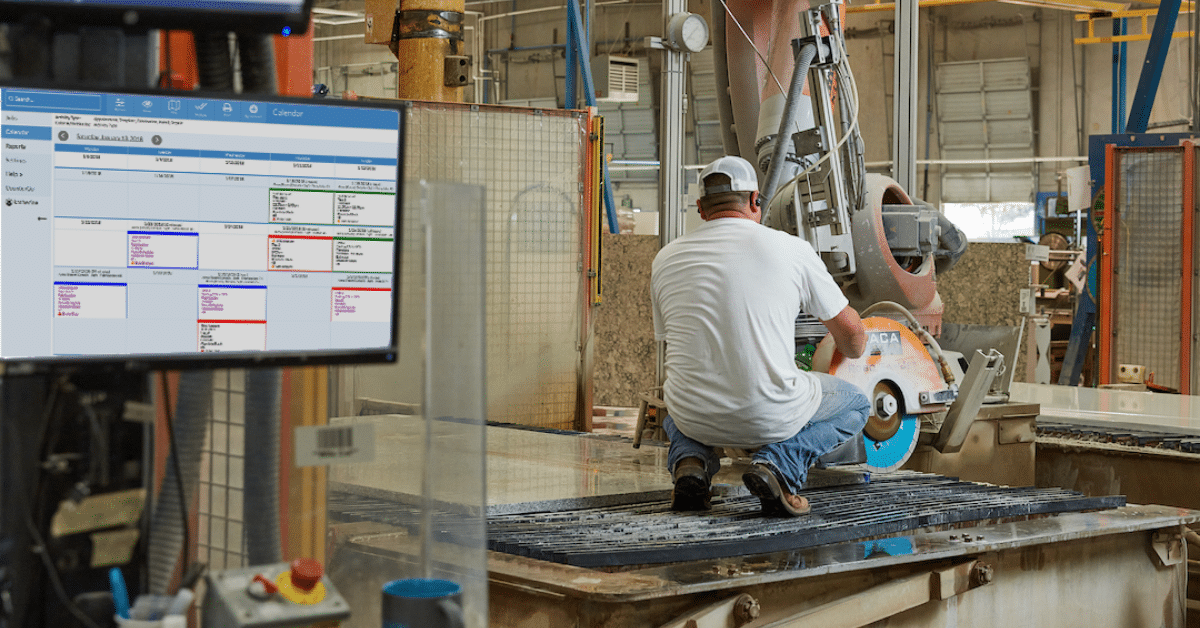What words come to mind when you think about your scheduling process? For a lot of fabricators – especially those with smaller operations – it’s chaos.
Striking the right balance of supply and demand is what scheduling is all about, but when everyone at your shop is adding jobs, removing them, and making changes, that delicate balance gets thrown off.
Overbooking, underbooking, last-minute additions, and forgetting about holidays are incredibly common, especially when there’s no defined process in place for scheduling.
When your shop has too much on its plate, more mistakes are likely to be made. Not to mention some of your best staff members can get burnt out and leave, and replacing talent in this industry is incredibly difficult.
All of this boils down to a lower margin in an already low-margin industry. But don’t worry – there is a better way, and we’ve gathered some tips from the most successful fabricators to share with you!
Why Focus On Scheduling?
Scheduling is typically one of many bottlenecks fabricators are facing. What makes the scheduling problem so important?
If you think about it, the schedule is the heart of your business. It’s what keeps everything else alive. Providing amazing service, having stress-free days, and keeping up with demand all rely on good scheduling.
If you overbook, then you have to call the customer and reschedule, but they just took off work to meet you, and now they want to be compensated for their time. It’s a world of hurt just waiting for you at the end of an already stressful day.
💡Read: Centralize your job information for more peace of mind
Set Scheduling Goals and Targets
When you look at your current scheduling process, what are your goals? Are you simply trying to fill up the day? Let’s try to take a more strategic approach.
As a shop owner, what if you doubled down and considered the following:
- How much does it cost to run this business each month?
- How much do I want to take home each month?
- What profit margin am I aiming for?
Count how many days you’ll be working, divide your goals by those days, and back into a daily production goal. For many shops, square footage is the metric that makes the most sense.
For example, say you want to make $250,000 per month, and your crew is working 22 days this month. That means you need to bring in just over $11,300 per day. If you know your average cost per square foot is $25, you know you need to schedule about 450 square feet of work each day.
Now, you have a schedule with a purpose. You’re no longer just trying to fill up the day – you’re trying to meet the daily production goal.
Make One Person Responsible for Scheduling
One simple tip that has helped a handful of fabricators is making one person responsible for scheduling. If one person can “own” the scheduling process, it cuts down on a lot of the miscommunications that cause all those expensive mistakes.
No matter what tool you use – a whiteboard, Google Sheets, Excel, Outlook, Systemize, or other software – having one scheduler will prevent overworked employees and miscommunications that lead to remakes and reworks.
Instead, it’ll improve communication both internally and externally.
If the customer doesn’t need a date right away, the salesperson could email the scheduler with the request, and if it’s more urgent like answering the customer in the showroom, just give the scheduler a call to confirm then and there on the spot. Impressive!
🎥 Watch or Read: Humboldt Countertops says to assign one point person for consistency
Set Up Scheduling Guidelines
Many shops benefit from having a barrier to entry, so to speak. For example, you won’t put a customer on the schedule unless you have the following info:
- Basic contact information
- Measurements
- Color choices
- Other contractor dates
- Upcoming deadlines
- Payment information or a deposit
It’s up to your shop to figure out what you deem necessary, but be careful of putting anyone and everyone on the schedule. If you’re missing critical information, it can wreak havoc on your entire schedule when the day does come, because you don’t have the information you need to be successful.
It can feel uncomfortable to be pushy with your customer, but it’s in their best interest. It might be useful to find a way to share why you are asking for all this info upfront so they understand the benefit.
Map It Out With Systemize
An added benefit of having a scheduler use software like Systemize is being able to map out a more efficient schedule. Our mapping service shows the location of all activities for the day on a single map.
If you have multiple install crews, you can make sure they’re not crossing paths all day – instead, you can make sure they’re doing jobs that are near each other. That’ll end up costing less, and it’ll make time for more jobs.
AutoSchedule to Save Time
Another quick benefit of using Systemize is being able to AutoSchedule activities.
Do you typically need three days after templating before you start on fabrication? Do you generally need three more days before you start on the Install? Should the invoice be sent the day after installation?
All of these tasks can be automatically added to your calendar with Systemize. That keeps important tasks from falling through the cracks.
How can you get started?
Having a successful countertop shop starts with an efficient scheduling system. And if everyone on staff is adding, removing, and making changes at the last minute, it’s no wonder you’re stressed and customers aren’t bending over backward to send you referrals!
Making one person responsible for scheduling can smooth out your days and provide a better customer experience, which ultimately helps your shop earn more revenue.
Interested in using Systemize to help you streamline your processes? Schedule a demo!



